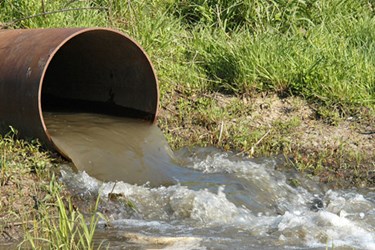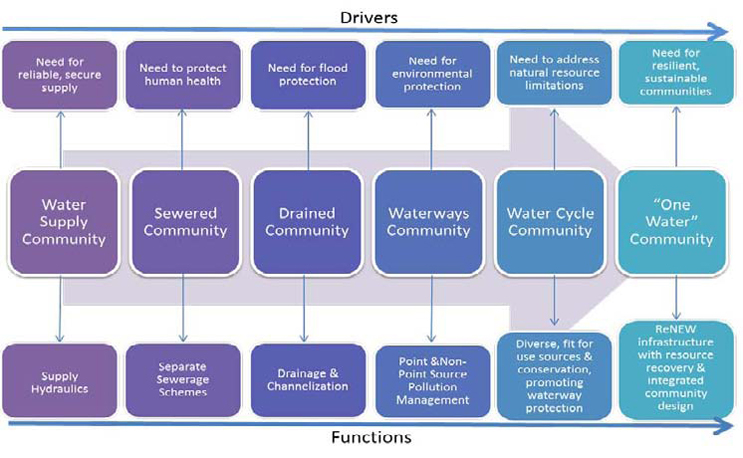Solving Sewer Overflows: Green Or Gray, WERF Shows The Way

By Kimberly Davis
A leading research organization investigates wet weather strategies to help municipalities make informed decisions about stormwater management.
The Water Environment Research Foundation (WERF) has been researching issues related to combined sewer overflows (CSO) for nearly 20 years. The scope of WERF’s research portfolio has spanned from assessments of emerging technologies, to improved wet weather treatment, to more recent examinations of the response of fish to hypoxia and CSOs in the field. Notable among the projects have been:
- Best Practices for the Treatment of Wet Weather Wastewater Flows (00CTS6)
- Characterizing the Quality of Effluent and Other Contributory Sources During Peak Wet Weather Events (03CTS12PP)
- Decentralized Stormwater Controls for Urban Retrofit and Combined Sewer Overflow Reduction (03SW3)
Going Green
Recently, WERF and water resource recovery facilities (WRRFs) have been striving to better understand how green infrastructure (GI) can complement conventional gray infrastructure such as piping, wet weather technologies, and treatment refinements. A recent WERF report, Institutional Issues for an Integrated “One Water” Approach (SIWM2T12), identifies green infrastructure as infrastructure that works with and mimics nature. GI enables a built environment that supports the natural environment.
In the SIWM2T12 research, approximately 30 case studies evaluated a variety of “one-water” approaches. Several of them focused on CSO management. In particular, the research illustrates how Philadelphia Water undertook a comprehensive initiative to establish the optimal ratio of gray-to-green infrastructure projects and a standard unit of measure to quantify the GI benefits. Effectiveness of measures evaluated included:
- Stormwater fees
- Daylighting streams
- “Green Street” blocks
- Removal of impervious paving
- Green schools and green roofs
- Park transformations for GI features
- Engagement with private businesses for greening projects
The resulting Philadelphia Water Evaluation and Adaptation Plan incorporating these demonstrated techniques is due in fall 2016. Transferable actions from the initiative included findings such as:
- Remain open and adaptable to public feedback, and work to find solutions that address stakeholder concerns.
- Adopt standardized, measurable units so that all institutions and stakeholders have a clear understanding and baseline from which to plan.
- Emphasize multiple benefits (economic, environmental, and societal) to encourage monetary feasibility of project adoption.
- Create watershed partnerships and stakeholder networks to assist with community outreach and more easily identify, receive, and appropriately allocate funds for a project.
Communication And Collaboration
The research also highlights the Atlanta CSO long-term control plan (LTCP), which included a public education and involvement program for citizens for its CSO Remediation Plan under its federal consent decree. Atlanta sought better understanding by the public, in particular regarding actions with significant cost — and sometimes temporary infrastructure disruption — including:
- Separation of sewer basins to increase Atlanta’s separate sanitary sewer network to 90 percent
- Construction of a deep-rock tunnel storage and treatment system to capture and store combined flows for two quadrants of the combined sewer network
- Reduction of the number of permitted, wet weather overflows from the combined sewer system from 360 per year to an average of four per year
Northern Kentucky Sanitation District #1 (NKSD#1) was also studied. They sought to maximize the impact of expenditures for CSO/SSOs, as required by a U.S. EPA consent decree, given restrictive state and federal regulations about options. NKSD#1 had 1.8 billion gallons in CSOs annually and another 240 million gallons in SSOs. However, an assessment found that failing septic systems and the loss of riparian corridor contributed more pollution to the receiving waterbody than did the SSOs.
To address the CSOs/SSOs, customers experienced rate increases annually for all but two of the previous 14 years. NKSD#1 sought to evaluate measures that could be more cost-effective. But state and federal regulations did not permit “pollution trading,” nor did they recognize the efficacy of local land use regulations in reducing pollution. Yet involving measures relying on such intergovernmental collaboration would permit greater nonpoint pollution reduction for the smallest fee increases.
NKSD#1 (which is both the sanitation and the stormwater district) approached the Northern Kentucky Water District and the Northern Kentucky Area Planning Commission for collaborative discussion, assessment, and identification of successful strategies. The result was a series of local agreements encouraging GI solutions, along with a targeted regional plan. Finally, the necessary state law was enacted, requiring regulators to consider affordability, GI, and effectiveness when enforcing the Clean Water Act (CWA) and in working with local entities to develop compliance programs.
The innovative work from this project can be replicated. The U.S. Conference of Mayors is developing informational documents to address policy concerns with the EPA, highlighting more adaptive management approaches in context of the difficulty in implementing creative solutions due to regulations. Ideally, these efforts will ultimately lead to the modification of the CWA.

Sustainable integrated water management continuum (Source: WERF report number SIWM2T12, Institutional Issues for Integrated ‘One Water’ Management. Published in 2015.)
Data-Driven Solutions
In 2015, WERF also released a report known as the NYCDEP Metering Pilot Study (WERF2P13). There, the New York City Department of Environmental Protection (NYCDEP) evaluated improved flow monitoring telemetry to improve the accuracy of predictions and for more robust modeling of gray-to-green alternatives for cost-effectiveness in its Long-Term Control Program. The resulting comparative analysis provided a holistic look at the CSO drainage area and allows for a better understanding of the interrelationship between drainage area characteristics and overflow discharge volumes.
In addition to an updated calibrated model, the study identified improvements necessary in instrumentation and triggering, due to the flow characteristics of high tides and tide gates. Adjustments to instrumentation will be used in both the hydraulic model and for real-time controls.
Perhaps WERF’s best-known work supporting WRRFs large and small in CSOs, The Sustainable Infrastructure Management Program Learning Environment (SIMPLE), was based on their partnerships, case studies, and collaboration with WRRFs such as those mentioned previously. SIMPLE, a knowledge base on strategic asset management (SAM) in Web format, was designed specifically for the wastewater industry. SIMPLE incorporates wastewater-specific asset management tools, graphics, guidelines, templates, interactive training aids, a glossary of terms, Web links, and relevant wastewater references.
SIMPLE breaks asset management into seven concepts:
- Asset inventory
- Data standards
- Level of service
- Risk/failure analyses
- Capital improvement plans
- Life-cycle costs
- Maintenance programs
SIMPLE also includes “Forums and Support” which allow users to ask questions to facilitate interaction among utility staff across the country. This approach encourages a sharing of knowledge and experiences to avoid “reinventing the wheel.”
In 2016, WERF will seek to further refine understanding of the cobenefits of GI for communities. WERF researchers will be asked to find the actual and hidden life-cycle costs of green and gray infrastructure projects — particularly when used to prevent combined sewer overflows. Many municipalities have commissioned their own studies to identify the full costs and benefits (via triple-bottom-line assessments) of conventional versus green infrastructure options for controlling CSO events. By building on work such as 21st Century Water Asset Accounting, WERF will produce research that will result in increased confidence in comparisons of both the costs and benefits of green infrastructure alternatives to manage CSO challenges.
About The Author
 Kimberly Davis is an environmental compliance analyst and researcher in urban infrastructure planning, with a systems approach to water, wastewater, stormwater, and renewable energy. Kimberly is a graduate of Trinity University in San Antonio, TX, and received a master’s in Urban Planning from New York University.
Kimberly Davis is an environmental compliance analyst and researcher in urban infrastructure planning, with a systems approach to water, wastewater, stormwater, and renewable energy. Kimberly is a graduate of Trinity University in San Antonio, TX, and received a master’s in Urban Planning from New York University.
